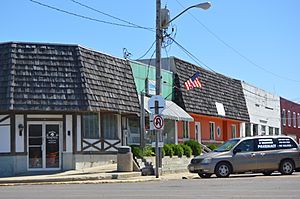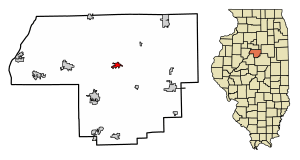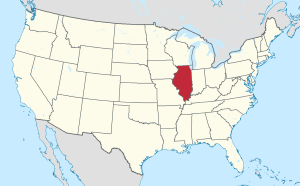Roanoke, Illinois facts for kids
Quick facts for kids
Roanoke
|
|
|---|---|
|
Village
|
|

Broad Street downtown
|
|

Location of Roanoke in Woodford County, Illinois.
|
|

Location of Illinois in the United States
|
|
| Country | United States |
| State | Illinois |
| County | Woodford |
| Area | |
| • Total | 0.97 sq mi (2.52 km2) |
| • Land | 0.94 sq mi (2.43 km2) |
| • Water | 0.04 sq mi (0.09 km2) |
| Elevation | 724 ft (221 m) |
| Population
(2020)
|
|
| • Total | 1,960 |
| • Density | 2,089.55/sq mi (806.94/km2) |
| Time zone | UTC-6 (CST) |
| • Summer (DST) | UTC-5 (CDT) |
| ZIP Code(s) |
61561
|
| Area code(s) | 309 |
| FIPS code | 17-64590 |
| Wikimedia Commons | Roanoke, Illinois |
Roanoke is a small village located in Woodford County, Illinois, in the United States. It's a part of the larger Peoria area. In 2020, about 1,960 people lived here.
Contents
History of Roanoke Village
How Roanoke Began: Early Settlement
Before 1850, much of northern Illinois was wild land. Only a few people lived there, mostly near Chicago or along rivers. This changed in 1850 when President Millard Fillmore signed a special land grant. This grant helped build the Illinois Central Railroad. Important lawyers like Stephen Douglas and Abraham Lincoln worked to make this happen.
The railroad brought new chances for people to settle in Central Illinois. Many immigrants from Germany, the Netherlands, Ireland, Italy, and Sweden moved to Woodford County. Roanoke was one of these new places.
On December 17, 1872, Roanoke was officially planned out. Land plots were put up for sale. The village was set up with 15 blocks. Two years later, in 1874, Roanoke officially became a "Village" in Illinois. Buildings quickly went up. By the time the railroad was finished, about 300 people lived there. On August 15, 1874, the first election was held. Six trustees were chosen to lead the Village of Roanoke. These positions are still filled today.
Coal Mining in Roanoke
Like many places in Illinois, the Roanoke area has rich coal underground. The second coal mine in Woodford County started in Roanoke in 1881. At its busiest, the mine employed about 300 men. They dug up 500 tons of coal every day!
Working in the mines was often dangerous. On June 29, 1906, four men tragically fell 400 feet down the main shaft. They were doing repairs when the accident happened. After this sad event, the coal mine kept working until 1940. It closed because of safety worries and maintenance problems. In 1941, the tall structure above the mine, called a "tipple," fell into the shaft. This left a big hole. The hole was later filled in, and the remaining equipment was sold.
Rocks and waste from the mine were piled into a huge mound. People called it the "Jumbo." It's on the south side of the village. Since before the mine closed, about 800,000 tons of this material have been used. It helped build roads and improve the town. The Jumbo is smaller now, but it still stands. During Christmas, an electric star lights up its top.
The Railroad's End
After the Roanoke mine closed in 1940, trucks became more popular for moving crops. Because of this, the train line through Roanoke was eventually shut down. This happened in the mid-1980s. The tracks were removed and sold for scrap. The original Roanoke train station building is still standing today. It is now a historic landmark.
The 2004 Roanoke Tornado
On July 13, 2004, a very strong F4 tornado hit the area. It destroyed several homes and farms. It also damaged the Parsons Manufacturing Plant. This plant was about 4 miles (6.4 km) west of downtown Roanoke. Over 200 people were inside the plant at the time. Amazingly, no one was seriously hurt or died. Many people took photos and videos of this powerful storm.
Roanoke's Location and Land
Roanoke is located at 40°47′51″N 89°11′59″W / 40.79750°N 89.19972°W.
According to the 2010 census, Roanoke covers about 0.957 square miles (2.48 square kilometers). Most of this area, about 96%, is land. The rest, about 4%, is water.
People of Roanoke: Demographics
| Historical population | |||
|---|---|---|---|
| Census | Pop. | %± | |
| 1880 | 355 | — | |
| 1890 | 831 | 134.1% | |
| 1900 | 966 | 16.2% | |
| 1910 | 1,311 | 35.7% | |
| 1920 | 1,368 | 4.3% | |
| 1930 | 1,088 | −20.5% | |
| 1940 | 1,090 | 0.2% | |
| 1950 | 1,368 | 25.5% | |
| 1960 | 1,821 | 33.1% | |
| 1970 | 2,040 | 12.0% | |
| 1980 | 2,001 | −1.9% | |
| 1990 | 1,910 | −4.5% | |
| 2000 | 1,994 | 4.4% | |
| 2010 | 2,065 | 3.6% | |
| 2020 | 1,960 | −5.1% | |
| U.S. Decennial Census | |||
In 2000, there were 1,994 people living in Roanoke. They lived in 765 households, with 559 of these being families. The village had about 2,192 people per square mile (846 per square kilometer). Most people (99.15%) were White. A small number were African American, Native American, or Asian.
About 31.5% of households had children under 18. Many households (64.6%) were married couples. About 25% of all households were people living alone. The average household had 2.52 people.
The population was spread out by age:
- 24.3% were under 18 years old.
- 7.6% were 18 to 24 years old.
- 24.8% were 25 to 44 years old.
- 21.4% were 45 to 64 years old.
- 21.9% were 65 years or older.
The average age in the village was 40 years old.
The median income for a household was $43,125. For families, it was $54,750. About 4.9% of the people lived below the poverty line. This included 6.3% of those under 18.
Famous People from Roanoke
- Frank Frantz (1872–1941): He was a Rough Rider. He also served as the last Governor of Oklahoma Territory.
- Glen Gray (1900–1963): A famous jazz saxophonist and orchestra leader. He was born in Roanoke. He graduated from Roanoke High School in 1917.
- William E. Warner: A professor of industrial arts at Ohio State University. He founded the Epsilon Pi Tau honor society.
Images for kids
See also
 In Spanish: Roanoke (Illinois) para niños
In Spanish: Roanoke (Illinois) para niños




